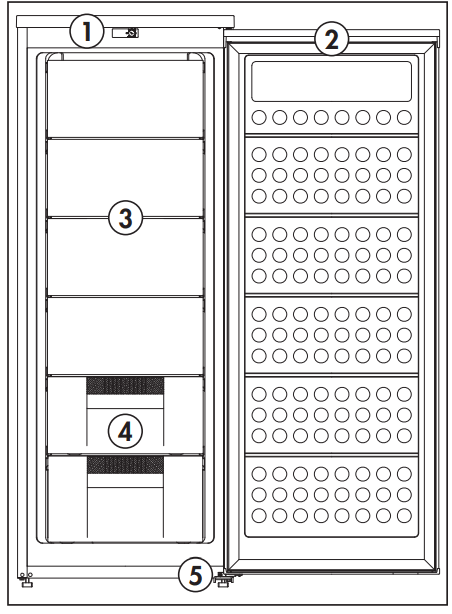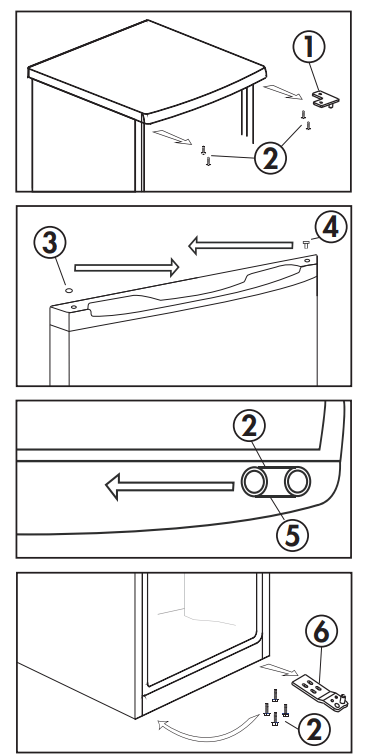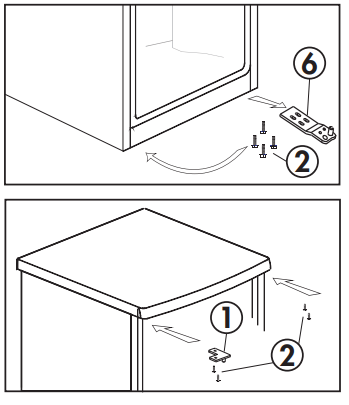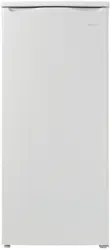Documents: Go to download!
- User Manual - (English, French, Spanish)
- INSTALLATION INSTRUCTIONS
- OPERATING INSTRUCTIONS
- CARE & MAINTENANCE
- TROUBLESHOOTING
- Important Safety Information
Table of contents
OWNER’S MANUAL UPRIGHT FREEZER
INSTALLATION INSTRUCTIONS
LOCATION
- Two people should be used when moving the appliance.
- Remove interior and exterior packaging prior to installation. Wipe the outside of the appliance with a soft, dry cloth and the inside with a lukewarm wet cloth.
- Place the appliance on a floor that is strong enough to support it when it is fully loaded.
- Do not place the appliance in direct sunlight or near sources of heat, such as a stove or heater, as this can increase electrical consumption. Extreme cold ambient temperatures may also cause the appliance to perform improperly.
- Do not use the appliance near water, for example, in a wet basement or near a sink.
- This appliance is intended for indoor household use only. It is not designed for outside installation, including anywhere that is not temperature controlled (garages, porches, vehicles, etc.).
- Before connecting the appliance to a power source, let it stand upright for approximately 6 hours. This will reduce the possibility of a malfunction in the cooling system from handling during transportation.
- This appliance is 54.5 cm (21.5 inches) wide by 143 cm (56.3 inches) high by 56.6 cm (22.3 inches) deep. Make sure that you leave the minimum amount of space between the appliance and all surrounding walls and vents.
- Allow 12.7 cm (5 inches) of space between the back, sides and top of the appliance and all adjacent walls.
- This appliance is intended for free-standing installation only and is not intended to be built into a cabinet or counter. Building in this appliance can cause it to malfunction.
OPERATING INSTRUCTIONS
FEATURES
1. Thermostat Dial
2. Magnetic Gasket
3. Wire Shelves
4. Plastic Bins
5. Adjustable Feet

IMPORTANT NOTE
- The freezer door may be difficult to open immediately after closing it. This is normal and is due to the pressure difference between the cold interior of the freezer and the warm air that has just entered the freezer when the door was opened. The pressure will equalize within a few minutes.
- If the door is especially difficult to open, wait 5 minutes to allow the pressure to equalize and then try again.
- The interior dimensions of this appliance are: 36.5 cm (15.6 inches) wide by 125.6 cm ( 49.5 inches) high by 39.9 cm (15.7 inches) deep.
TEMPERATURE SELECTION
The temperature of the appliance can be adjusted by turning the thermostat dial.
- The number 1 position indicates the warmest temperature setting. The number 4 position indicates the coldest temperature setting. The number 2 or 3 position should be sufficient for regular home use.
- The temperature range of the appliance is approximately -15°C (5°F) to -24°C (-11°F).
- The temperature inside the appliance can vary based on ambient room temperature, the frequency that the door is opened and the amount of fresh food that has recently been added to the appliance.
- To stop the cooling function, turn the control knob to the “OFF” position.
- Do not overload the appliance or attempt to freeze large quantities of fresh food at one time as this can affect performance.

LEVELING INSTRUCTIONS
There are two adjustable feet on the bottom of the appliance that can be turned up or down to ensure that the appliance is level.
- Turn the adjustable feet counter-clockwise until the top of the feet are touching the bottom of the cabinet.
- Slowly turn the adjustable feet clockwise until the appliance is level.
DEFROSTING
This appliance should be defrosted approximately twice a year or when a 6 mm (1/4 inch) layer of frost has formed on the shelves. Protect flooring by placing towels or a pan under the appliance to collect any defrost water that may leak from the appliance.
- Turn the thermostat dial to the “0” position and unplug the power cord.
- Remove all contents and leave the door open.
- Check the appliance frequently while defrosting to ensure that water does not leak and cause damage to flooring.
- When all frost has melted, wipe the interior of the appliance with a towel or sponge to ensure it is completely dry before resuming operation.
- Plug the appliance in, turn the thermostat dial to the desired setting and replace all contents once the appliance has reached the desired temperature.
IMPORTANT: Never use electrical appliances during defrosting. Do not use pointed or sharp objects to remove frost as this can damage the refrigerant lines. If these lines are accidentally pierced it will render the freezer inoperable and void the manufacturer’s warranty
DOOR REVERSAL INSTRUCTIONS
If the appliance is placed on its back or side for any length of time during this process, it must be allowed to remain upright for 6 hours before plugging it in to avoid damage to the internal components.


1. Upper Hinge
2. Screws
3. Hinge Hole Cover
4. Bushing
5. Door Stop
6. Lower Hinge
- Open the door and unscrew the upper hinge from the right side of the worktop. Remove the door from the cabinet. Remove the screws in the left side of the work top. These will be used to secure the upper hinge later.
- Remove the hinge hole plug from the top left side of the door and the bushing from the top right side of the door and swap their positions.
- Remove the door stop from the bottom right side of the door and install it on the bottom left side of the door.
- Remove the lower hinge from the bottom right side of the cabinet and install it on the bottom left side of the cabinet.
- Install the door on the lower hinge. Install the upper hinge on the top left side of the worktop.
Note: When installing the door, ensure that the top of the door is level with the top of the cabinet. If the door is not level, the rubber gasket will not make a good seal with the cabinet which can cause the appliance to malfunction.
CARE & MAINTENANCE
CLEANING
Ensure the appliance is unplugged before cleaning.
- To clean the inside of the appliance, use a soft cloth and a solution of one tablespoon of baking soda to one quart of water or a mild detergent solution.
- Wash removable shelves in a mild detergent solution, then dry and wipe with a soft cloth.
- Clean the outside with a soft, damp cloth and some mild detergent.
- It is important to keep the area clean where the door seals against the cabinet. Clean this area with a soapy cloth. Rinse with a damp cloth and let dry.
Note: Do not use cleaners containing ammonia or alcohol on the appliance. Ammonia or alcohol can damage the appearance of the appliance. Never use any commercial or abrasive cleaners or sharp objects on any part of the appliance.
POWER FAILURE
- Most power failures are corrected within a few hours and should not affect the temperature of your appliance if you minimize the number of times the door is opened. If the power is going to be off for a longer period of time, take the proper steps to protect your contents.
Note: Wait 3 to 5 minutes before attempting to restart the refrigerator if operation has been interrupted.
VACATION
- Short vacations: Leave the appliance operating during vacations of less than three weeks.
- Long vacations: If the appliance will not be used for several months, remove all items and turn off the appliance. Clean and dry the interior thoroughly. To prevent odor and mold growth, leave the door open slightly, blocking it open if necessary
ENERGY SAVING TIP
The appliance should be located in the coolest area of the room, away from heat producing appliances, and out of direct sunlight. Do not overload the unit or block any ventilation openings.
MOVING
- Remove all contents.
- Securely tape down all shelves inside the appliance.
- Turn the adjustable leg up to the base to avoid damage.
- Tape the door shut.
- Be sure the appliance stays secure in the upright position during transportation. Protect the outside of the appliance with a blanket.
- If the appliance is placed on its back or side during transportation, upon reaching the destination, allow it to remain upright for 6 hours before plugging in to avoid damage to internal components.
DISPOSAL
This appliance may not be treated as regular household waste, it should be taken to the appropriate waste collection point for recycling of electrical components. For information on local waste collection points, contact your local waste removal agency or government office.
TROUBLESHOOTING
PROBLEM | POSSIBLE CAUSE |
| No power |
|
| Internal temperature not cold enough |
|
| Appliance runs continuously |
|
Important Safety Information
READ AND FOLLOW ALL SAFETY INSTRUCTIONS
SAFETY REQUIREMENTS
DANGER: Risk of fire or explosion. Flammable refrigerant used. Do not puncture refrigerant tubing.
- Do not use mechanical devices to defrost refrigerator.
- Ensure that servicing is done by factory authorized service personnel, to minimize product damage or safety issues.
- If the power supply cord is damaged, it must be replaced by the manufacturer, its service agent or similar qualified person in order to avoid hazard.
- Consult repair manual or owner’s guide before attempting to service this product. All safety precautions must be followed.
- Dispose of properly in accordance with federal or local regulations.
- Follow handling instructions carefully.
- Do not store explosive substances such as aerosol cans with a flammable propellant in this appliance.
WARNING: Keep ventilation openings, in the appliance enclosure or in the built-in structure, clear of obstruction.
WARNING: Do not use mechanical devices or other means to accelerate the defrosting process, other than those recommended by the manufacturer.
WARNING: Do not damage the refrigerant circuit.
WARNING: Do not use electrical appliances inside the food storage compartments of the appliance, unless they are of the type recommended by the manufacturer.
CAUTION: Children should be supervised to ensure that they do not play with the appliance.
DANGER: Risk of child entrapment. Before throwing away an old appliance:
- Remove the door or lid.
- Leave shelves in place so that children may not easily climb inside.
DANGER: Do not add a lock to the door or lid. This can cause child entrapment and harm.
SAFETY REQUIREMENTS
This appliance is not intended for use by persons (including children) whose physical, sensory or mental capabilities may be different or reduced, or who lack experience or knowledge, unless such persons receive supervision or training to operate the appliance by a person responsible for their safety.
This appliance is intended to be used in household and similar applications such as:
- Staff kitchen areas in shops, offices and other working environments;
- Farm houses and by clients in hotels, motels and other residential type environments;
- Bed and breakfast type environments;
- Catering and similar non-retail applications.
GROUNDING INSTRUCTIONS
This appliance must be grounded. Grounding reduces the risk of electrical shock by providing an escape wire for the electrical current.
This appliance has a cord that has a grounding wire with a 3-prong plug. The power cord must be plugged into an outlet that is properly grounded. If the outlet is a 2-prong wall outlet, it must be replaced with a properly grounded 3-prong wall outlet. The serial rating plate indicates the voltage and frequency the appliance is designed for.
WARNING - Improper use of the grounding plug can result in a risk of electric shock. Consult a qualified electrician or service agent if the grounding instructions are not completely understood, or if doubt exists as to whether the appliance is properly grounded.
Do not connect your appliance to extension cords or together with another appliance in the same wall outlet. Do not splice the power cord. Do not under any circumstances cut or remove the third ground prong from the power cord. Do not use extension cords or ungrounded (two prongs) adapters
See other models: DCF050B1WM DPG37G DBC120BLS DH016A1W-1 DCR044A4BBSL
